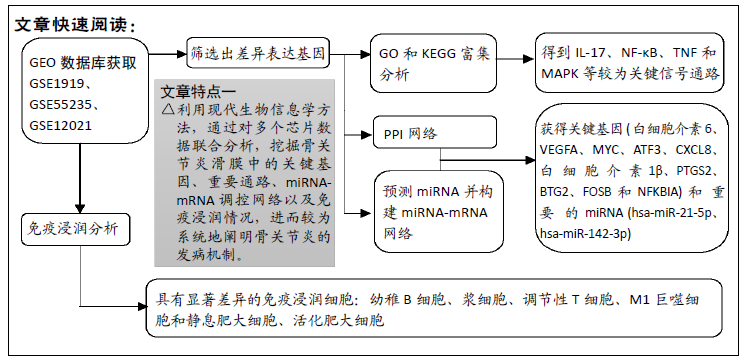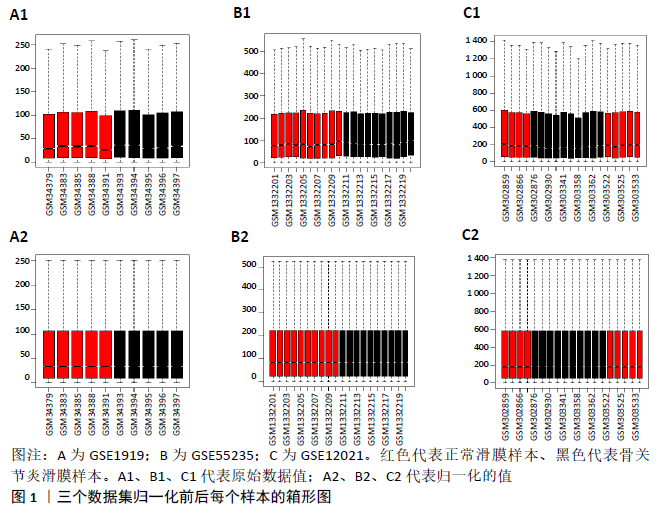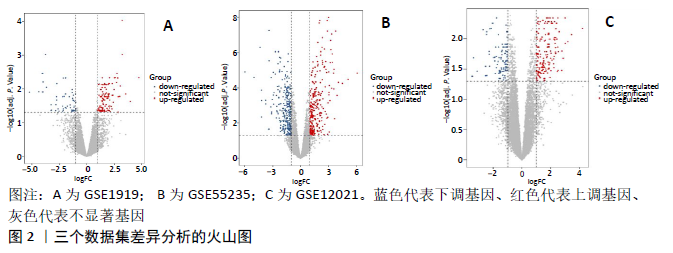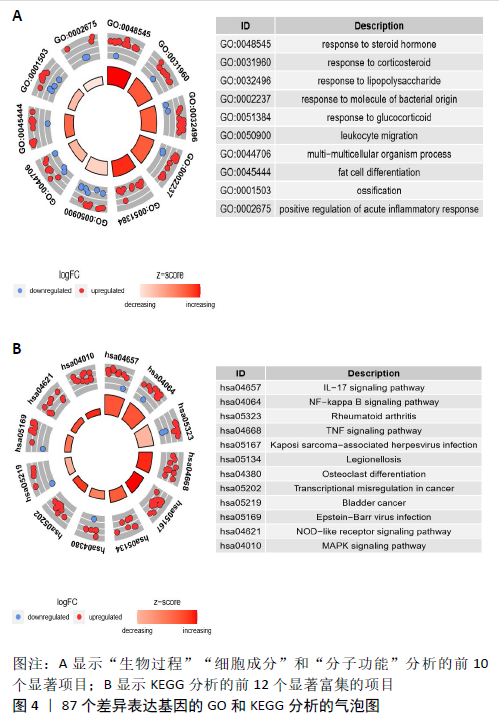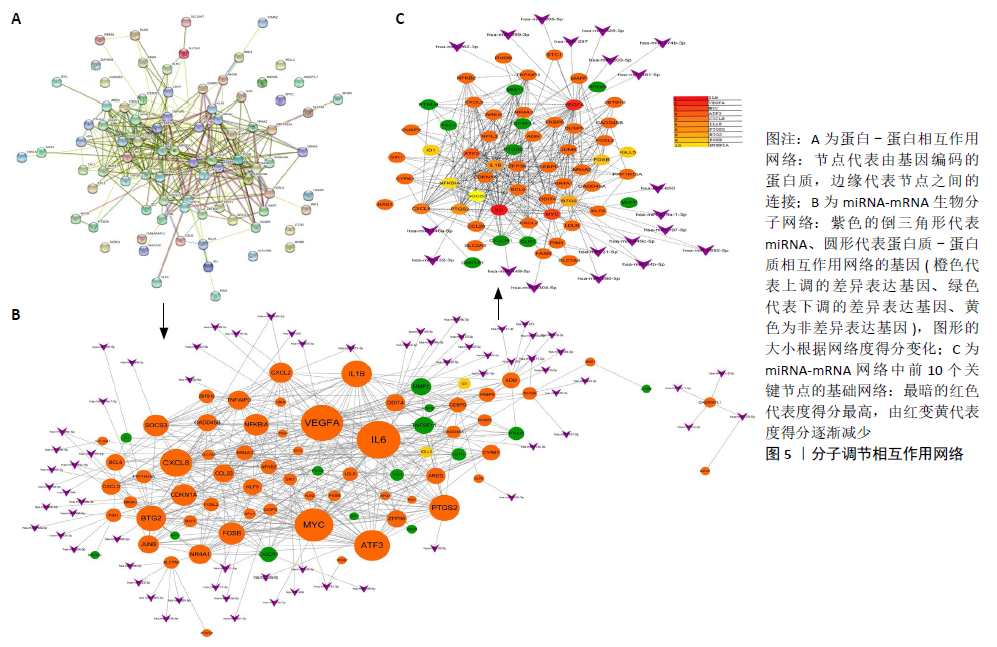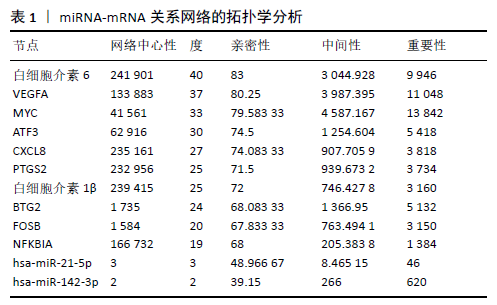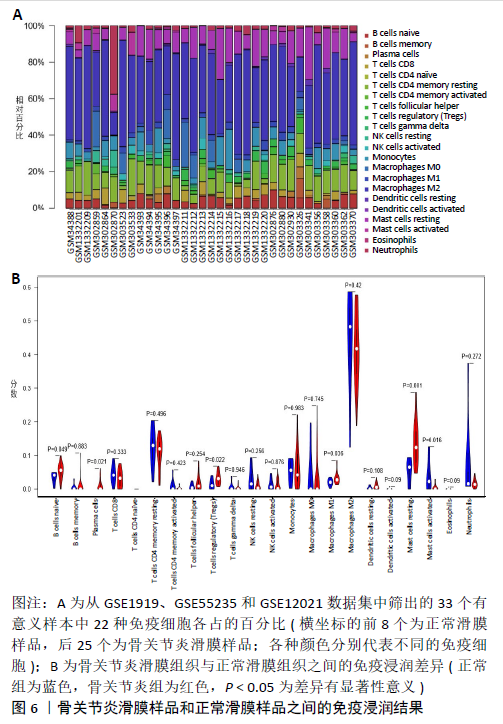[1] GLYN-JONES S, PALMER AJ, AGRICOLA R, et al. Osteoarthritis. Lancet. 2015; 386(9991):376-387.
[2] VINA ER, KWOH CK. Epidemiology of osteoarthritis: literature update. CurrOpinRheumatol. 2018;30(2):160-167.
[3] LI MH, XIAO R, LI JB, et al. Regenerative approaches for cartilage repair in the treatment of osteoarthritis. Osteoarthritis Cartilage. 2017;25(10):1577-1587.
[4] 何超鹏,陈铖,蒋欣宸,等.失配性因素在骨关节炎发病机制中的作用[J].国际骨科学杂志,2019,40(6):353-356.
[5] BERENBAUM F. Osteoarthritis as an inflammatory disease (osteoarthritis is not osteoarthrosis!). Osteoarthritis Cartilage. 2013;21(1):16-21.
[6] FURMAN BD, KIMMERLING KA, ZURA RD, et al. Articular ankle fracture results in increased synovitis, synovial macrophage infiltration, and synovial fluid concentrations of inflammatory cytokines and chemokines. Arthritis Rheumatol. 2015;67(5):1234-1239.
[7] ZENG C, LI YS, LEI GH. Synovitis in knee osteoarthritis: a precursor or a concomitant feature? Ann Rheum Dis. 2015;74(10):e58.
[8] SOKOLOVE J, LEPUS CM. Role of inflammation in the pathogenesis of osteoarthritis: latest findings and interpretations. TherAdvMusculoskelet Dis. 2013;5(2):77-94.
[9] 王学宗,丁道芳,薛艳,等.TLR4/NF-κB通路参与大鼠膝骨关节炎滑膜早期病变的研究[J].中国骨伤,2019,32(1):68-71.
[10] UNGETHUEM U, HAEUPL T, WITT H, et al. Molecular signatures and new candidates to target the pathogenesis of rheumatoid arthritis. Physiol Genomics. 2010;42A(4):267-282.
[11] WOETZEL D, HUBER R, KUPFER P, et al. Identification of rheumatoid arthritis and osteoarthritis patients by transcriptome-based rule set generation. Arthritis Res Ther. 2014;16(2):R84.
[12] HUBER R, HUMMERT C, GAUSMANN U, et al. Identification of intra-group, inter-individual, and gene-specific variances in mRNA expression profiles in the rheumatoid arthritis synovial membrane. Arthritis Res Ther. 2008;10(4):R98.
[13] LU TX, ROTHENBERG ME. MicroRNA.J Allergy ClinImmunol. 2018;141(4): 1202-1207.
[14] HERMANN W, LAMBOVA S, MULLER-LADNER U. Current Treatment Options for Osteoarthritis. CurrRheumatol Rev. 2018;14(2):108-116.
[15] FERNANDES JC, MARTEL-PELLETIER J, PELLETIER JP. The role of cytokines in osteoarthritis pathophysiology.Biorheology. 2002;39(1-2):237-246.
[16] HUNTER CA, JONES SA. IL-6 as a keystone cytokine in health and disease. Nat Immunol. 2015;16(5):448-457.
[17] KLOCKE R, LEVASSEUR K, KITAS GD, et al. Cartilage turnover and intra-articular corticosteroid injections in knee osteoarthritis. Rheumatol Int. 2018;38(3):455-459.
[18] HUANG Z, KRAUS VB. Does lipopolysaccharide-mediated inflammation have a role in OA? Nat Rev Rheumatol. 2016;12(2):123-129.
[19] SCANZELLO CR. Chemokines and inflammation in osteoarthritis: Insights from patients and animal models. J Orthop Res. 2017;35(4):735-739.
[20] JIANG Y, TIAN M, LIN W, et al. Protein Kinase Serine/Threonine Kinase 24 Positively Regulates Interleukin 17-Induced Inflammation by Promoting IKK Complex Activation. Front Immunol. 2018;9:921.
[21] AMATYA N, GARG AV, GAFFEN SL. IL-17 Signaling: The Yin and the Yang. Trends Immunol. 2017;38(5):310-322.
[22] LIU Y, PENG H, MENG Z, et al. Correlation of IL-17 Level in Synovia and Severity of Knee Osteoarthritis. Med SciMonit. 2015;21:1732-1736.
[23] JIMI E, FEI H, NAKATOMI C. NF-κB Signaling Regulates Physiological and Pathological Chondrogenesis. Int J Mol Sci. 2019;20(24):6275.
[24] RIGOGLOU S, PAPAVASSILIOU AG. The NF-κBsignalling pathway in osteoarthritis.Int J Biochem Cell Biol. 2013;45(11):2580-2584.
[25] PEGORETTI V, BARON W, LAMAN JD, et al. Selective Modulation of TNF-TNFRs Signaling: Insights for Multiple Sclerosis Treatment. Front Immunol. 2018;9:925.
[26] HOSSEINZADEH A, KAMRAVA SK, JOGHATAEI MT, et al. Apoptosis signaling pathways in osteoarthritis and possible protective role of melatonin. J Pineal Res. 2016;61(4):411-425.
[27] LUAN Y, KONG L, HOWELL DR, et al. Inhibition of ADAMTS-7 and ADAMTS-12 degradation of cartilage oligomeric matrix protein by alpha-2-macroglobulin. Osteoarthritis Cartilage. 2008;16(11):1413-1420.
[28] ZHAO Y, LI Y, QU R, et al. Cortistatin binds to TNF-α receptors and protects against osteoarthritis. EBioMedicine. 2019;41:556-570.
[29] SUN J, NAN G. The Mitogen-Activated Protein Kinase (MAPK) Signaling Pathway as a Discovery Target in Stroke. J MolNeurosci. 2016;59(1):90-98.
[30] SUN Y, LIU WZ, LIUT, et al. Signaling pathway of MAPK/ERK in cell proliferation, differentiation, migration, senescence and apoptosis. J Recept Signal Transduct Res. 2015;35(6):600-604.
[31] CHEN Y, SHOU K, GONG C, et al. Anti-Inflammatory Effect of Geniposide on Osteoarthritis by Suppressing the Activation of p38 MAPK Signaling Pathway. Biomed Res Int. 2018;2018:8384576.
[32] LAAVOLA M, LEPPÄNEN T, HÄMÄLÄINEN M, et al. IL-6 in Osteoarthritis: Effects of Pine Stilbenoids. Molecules. 2018;24(1):109.
[33] VICENTI G, BIZZOCA D, CARROZZO M, et al. Multi-omics analysis of synovial fluid: a promising approach in the study of osteoarthritis. J BiolRegulHomeost Agents. 2018;32(6 Suppl. 1):9-13.
[34] IEZAKI T, OZAKI K, FUKASAWA K, et al. ATF3 deficiency in chondrocytes alleviates osteoarthritis development. J Pathol. 2016;239(4):426-437.
[35] ZHAI G, PELLETIER JP, LIU M, et al. Activation of The Phosphatidylcholine to Lysophosphatidylcholine Pathway Is Associated with Osteoarthritis Knee Cartilage Volume Loss Over Time. Sci Rep. 2019;9(1):9648.
[36] LARSSON S, ENGLUND M, STRUGLICS A, et al. Interleukin-6 and tumor necrosis factor alpha in synovial fluid are associated with progression of radiographic knee osteoarthritis in subjects with previous meniscectomy. Osteoarthritis Cartilage. 2015;23(11):1906-1914.
[37] QIAO Z, TANG J, WU W, et al. Acteoside inhibits inflammatory response via JAK/STAT signaling pathway in osteoarthritic rats. BMC Complement Altern Med. 2019;19(1):264.
[38] XIONG H, LI W, LI J, et al. Elevated leptin levels in temporomandibular joint osteoarthritis promote proinflammatory cytokine IL-6 expression in synovial fibroblasts. J Oral Pathol Med. 2019;48(3):251-259.
[39] LU L, HUANG XW, XIE Y, et al. Clinical efficacy of intra-articular parecoxib injection for the treatment of early knee osteoarthritis. Zhongguo Gu Shang. 2019;32(5):418-422.
[40] LI H, PENG Y, WANG X, et al. Astragaloside inhibits IL-1β-induced inflammatory response in human osteoarthritis chondrocytes and ameliorates the progression of osteoarthritis in mice. ImmunopharmacolImmunotoxicol. 2019;41(4):497-503.
[41] MACDONALD IJ, LIU SC, SU CM, et al. Implications of Angiogenesis Involvement in Arthritis. Int J Mol Sci. 2018;19(7):2012.
[42] 梁治权,顾文飞,廖军.清热解毒通络汤联合塞来昔布对骨关节炎患者血清相关炎性因子水平的影响[J].中国医药,2018,13(3):433-436.
[43] 郭静,张娜,秦丽娟,等.膝骨关节炎患者中IL-18、VEGF和NF-κB的表达及意义[J].实用医学杂志,2013,29(18):3024-3026.
[44] NEES TA, ROSSHIRT N, ZHANG JA, et al. Synovial Cytokines Significantly Correlate with Osteoarthritis-Related Knee Pain and Disability: Inflammatory Mediators of Potential Clinical Relevance. J Clin Med. 2019;8(9):1343.
[45] SCHICK M, HABRINGER S, NILSSON JA, et al. Pathogenesis and therapeutic targeting of aberrant MYC expression in haematological cancers. Br J Haematol. 2017;179(5):724-738.
[46] YATSUGI N, TSUKAZAKI T, OSAKI M, et al. Apoptosis of articular chondrocytes in rheumatoid arthritis and osteoarthritis: correlation of apoptosis with degree of cartilage destruction and expression of apoptosis-related proteins of p53 and c-myc. J Orthop Sci. 2000;5(2):150-156.
[47] WU YH, LIU W, ZHANG L, et al. Effects of microRNA-24 targeting C-myc on apoptosis, proliferation, and cytokine expressions in chondrocytes of rats with osteoarthritis via MAPK signaling pathway. J Cell Biochem. 2018;119(10):7944-7958.
[48] 杨鹏.骨关节炎患者细胞因子/趋化因子表达谱分析以及CXCL8和CXCL11对软骨细胞的调节作用[D].西安:第四军医大学,2017.
[49] JIN Z, REN J, QI S. Human bone mesenchymal stem cells-derived exosomes overexpressing microRNA-26a-5p alleviate osteoarthritis via down-regulation of PTGS2. IntImmunopharmacol. 2020;78:105946.
[50] MANIAR KH, JONES IA, GOPALAKRISHNA R, et al. Lowering side effects of NSAID usage in osteoarthritis: recent attempts at minimizing dosage. Expert OpinPharmacother. 2018;19(2):93-102.
[51] YUNIATI L, SCHEIJEN B, VAN DER MEER LT, et al. Tumor suppressors BTG1 and BTG2: Beyond growth control. J Cell Physiol. 2019;234(5):5379-5389.
[52] BARRETT CS, MILLENA AC, KHAN SA. TGF-β Effects on Prostate Cancer Cell Migration and Invasion Require FosB. Prostate. 2017;77(1):72-81.
[53] LIU Y, MI B, LV H, et al. Shared KEGG pathways of icariin-targeted genes and osteoarthritis. J Cell Biochem.2018 Dec 3.doi: 10.1002/jcb.28048.
[54] WANG XB, ZHAO FC, YI LH, et al. MicroRNA-21-5p as a novel therapeutic target for osteoarthritis.Rheumatology (Oxford). 2019:kez102.
[55] WANG X, GUO Y, WANG C, et al. MicroRNA-142-3p Inhibits Chondrocyte Apoptosis and Inflammation in Osteoarthritis by Targeting HMGB1. Inflammation. 2016;39(5):1718-1728.
[56] WOODELL-MAY JE, SOMMERFELD SD. Role of inflammation and the immune system in the progression of osteoarthritis. J Orthop Res. 2020;38(2):253-257.
[57] TATEIWA D, YOSHIKAWA H, KAITO T. Cartilage and Bone Destruction in Arthritis: Pathogenesis and Treatment Strategy: A Literature Review. Cells. 2019;8(8):818.
[58] ZHOU Y, MING J, DENG M, et al. Berberine-mediated up-regulation of surfactant protein D facilitates cartilage repair by modulating immune responses via the inhibition of TLR4/NF-ĸB signaling. Pharmacol Res. 2020; 155:104690.
[59] HASEEB A, HAQQI TM. Immunopathogenesis of osteoarthritis.ClinImmunol. 2013;146(3):185-196.
[60] MORADI B, SCHNATZER P, HAGMANN S, et al. CD4⁺CD25⁺/highCD127low/⁻ regulatory T cells are enriched in rheumatoid arthritis and osteoarthritis joints--analysis of frequency and phenotype in synovial membrane, synovial fluid and peripheral blood. Arthritis Res Ther. 2014;16(2):R97.
[61] DE LANGE-BROKAAR BJ, IOAN-FACSINAY A, VAN OSCH GJ, et al. Synovial inflammation, immune cells and their cytokines in osteoarthritis: a review. Osteoarthritis Cartilage. 2012;20(12):1484-1499.
|
